Abstract
Functional traits are important indicators for examining ecological processes and after-effects of plant community restoration after large-scale geological disturbance. Sample sites with and without landslides in typical forest ecosystems within the region that experienced the highest intensity of the Wenchuan 8.0 earthquake in China were selected in this study, and the characteristics, variations, relationships and influencing factors of woody plant traits at the species, individual and functional type scales were studied. The total interspecific and intraspecific variation of woody plant functional traits was 62.02% and 14.86%, respectively. Differences in woody plant traits were observed at multiple ecological scales on landslides compared with those on nonlandslides. The differentiation of functional traits of recovering communities significantly decreased among woody plant functional types (WFTs) on landslides after the earthquake, indicating disruption and reorganization of the original functional structure. Woody plants on landslides adapted to the new environment by adjusting their leaf traits to improve light use efficiency and adopting rapid ecological strategies. In contrast, woody plants on nonlandslides were more inclined to accumulate material and support structures. Leaf thickness was sensitive to earthquakes. Leaf traits showed a high degree of synergy in their environmental response.
1. Introduction
Earthquakes are the external manifestation of the inherent internal movement of the Earth. They are a global and inevitable ecological process that causes great disturbance to ecological systems [1,2,3]. Earthquakes are difficult to accurately predict with current technology, but they are relatively fixed in their large-scale spatial distributions, e.g., geologically active zones [4]. Therefore, studying the response of plants to earthquakes in geologically active areas is helpful for a better understanding of the coevolutionary mechanisms of plants and local environments and to provide theoretical support for ecological restoration and ecological risk avoidance in geologically active zones.
Plant functional traits are the expression of plant adaptations to the environment and objectively reflect mutual adaptation between plants and the environment [3,5]. Plant functional traits are sensitive to environmental changes; therefore, they are often used as indicators of plant ecological readaptation strategies after habitat disturbance [5,6,7]. A previous study found that after 11 years of natural restoration of seismic landslides, plant functional traits at the community scale on landslides differed significantly from those on nonlandslides in the same region. This phenomenon was more pronounced in woody plants than in herbaceous plants, which may indicate that forests are more at risk from earthquakes than are grasslands [8]. Earthquakes and their secondary disasters mainly change regional topography, soil properties and water supply, which can be obviously reflected in plant functional traits [7]. For example, previous studies have suggested that leaf traits can reflect the functional changes in disturbed and regenerative processes in ecosystems, such as biomass accumulation, soil quality and material cycling [7,9]. Thus, plant functional traits are sensitive indicators for studying the ecological strategies of plants after large disturbances such as earthquakes.
Ecological strategies for traits are often discussed in terms of the economic spectrum, such as plants having “faster” to “slower” trait trade-offs as succession progresses [10,11]. The fundamental trade-offs between plant resource acquisition and conservation strategies are revealed by leaf traits [12,13]. In addition, trade-offs in plant traits during regeneration after disturbance are similar to those during succession [14,15]. In the early stage of regeneration after disturbance, plants are more willing to invest more resources in leaves and reproduction to obtain a higher light use efficiency and diffusion possibility, while in the later stage of restoration, plants are more inclined to invest in stems and other supporting structures to enhance their resource storage and competitiveness [5,7]. In this framework, a large leaf area, high leaf number, high specific root length and low-density tissue were considered resource acquisition strategies; in contrast, thick leaves, a high stem density, short specific root length and high tissue density were considered resource-saving strategies [16]. Although the theoretical framework mentioned above has not been fully verified in post-earthquake recovery succession, post-earthquake plant ecological strategies are worth studying because post-earthquake recovery is also a typical process of secondary succession. However, at the species scale, not all species in a real community fully conform to the theoretical framework mentioned above. For example, there are always some speculators (r life history strategy) and competitors (K life history strategy) in a community, and their trade-off strategies for traits are different [17]. To solve the above problems, plant functional type has been considered a sensitive indicator of trait trade-offs, and many interesting results have been reported. For example, several previous studies have divided plants into three functional types, namely, needleleaf evergreen, broadleaf deciduous and sclerophyllous broadleaf evergreen, and have noted that functional types are important predictors of plant traits [6,18]. However, there have been few reports on trait trade-off strategies based on plant functional types after earthquakes. The ecological patterns of trade-offs of woody forest plant traits after earthquakes at the species scale, individual scale and functional type scale are still unknown.
In this study, landslide and nonlandslide samples were selected in a typical temperate broadleaved forest in the region that experienced the highest intensity of the 8.0 Wenchuan earthquake in China. The characteristics, variations, relationships and influencing factors of woody plant functional traits at the species scale, individual scale, community scale and functional type scale were studied. This study aimed to provide a case for a better understanding of the variations in the ecological response strategies of plant functional traits after earthquakes and to elucidate the community assembly processes and mechanisms of forest recovery after large-scale natural disturbance in the future. Based on conclusions from previous research, the following hypotheses were made: (1) The variations in woody plant traits are different among different functional types in the earthquake zone. (2) Earthquakes cause differences in plant functional differentiation by affecting trait tradeoffs and correlations between traits. (3) The sensitivity of woody plant functional traits to earthquakes changes with different functional types and species, and some species are more sensitive than others. This study helps to enhance the general understanding of the ecological processes and mechanisms of geological disturbance and forest coevolution. It is also helpful for the selection of forest risk prediction indicators after large natural disturbances.
2. Materials and Methods
2.1. Study Area
This study was carried out in the Mozigou area (103.53° E–103.61° E, 31.10° N–31.17° N), which experienced the highest intensity of the Wenchuan 8.0 earthquake that occurred in China in 2008 (Figure 1). The study area covers approximately 70 km2. The altitude of this region ranges from 1100 m to 2800 m, with a maximum relative elevation of 1700 m. This region has a subtropical humid monsoon climate. The mean annual temperature is 12.5 °C. The mean annual relative humidity is higher than 80%, and the mean annual precipitation is approximately 1200 mm. Please refer to Table S1 in the Supplementary Materials for the detailed monthly mean climate data of the study area over nearly 50 years. The original vegetation is secondary forest and dominated by Acer laxiflorum, Toxicodendron vernicifluum, Houpoea officinalis, Litsea moupinensis, Meliosma cuneifolia and Lindera obtusiloba.
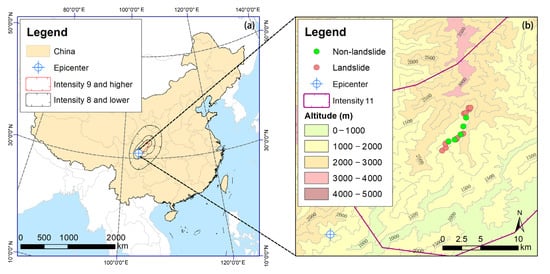
Figure 1.
Study area. (a) Ranges of areas with different earthquake intensities; (b) locations of sample sites. The dotted line shows the location of the sampling area in (a).
2.2. Data Collection and Measurement
2.2.1. Sample Selection
In the area that experienced the highest intensity of the 8.0 Wenchuan earthquake in China, 11 typical landslide sample sites and 5 nonlandslide sample sites (unaffected by the earthquake) from the same watershed were selected (Figure 1, details of the sampling points are shown in Table S2 in the Supplementary Material; a schematic diagram of the landslide structure is shown in Figure S1 in the Supplementary Material). All selected landslides were formed during the Wenchuan 8.0 earthquake to ensure that all study sites had a similar ecological context. This was determined using remote sensing images taken before and after the earthquake. Within each sample site, five 5 m × 5 m woody plant subplots (4 small blocks in the four corners and 5 small blocks in the center) were established [19,20]. The name and abundance of each species were recorded in each subquadrat. To better understand the geographical factors that influence the functional characteristics of landslide regeneration communities, altitude (ATT, M), slope (SLO) and transformation of slope aspect (ASP) were used to describe the new environmental characteristics after landslide formation.
2.2.2. Functional Types of Woody Plants
There have been many reports on the classification of functional types of woody forest plants, and there are two common classification methods. The first method classifies plants based on their leaf habit and form as either needleleaf evergreen, broadleaf evergreen, or broadleaf deciduous. This method is more suitable for mixed needle-broadleaf forests. The second method classifies woody plants according to the vertical layer (the ecological function of each layer) in which they are located. In this study, the forest was a typical temperate deciduous broadleaved forest lacking evergreen and coniferous plants; thus, the second classification method was more appropriate; that is, the plants were classified as belonging to the canopy layer (Arb, arbors), under-canopy layer (Shb: small arbors and shrubs) and interstratum plant layer (Wvc: woody vines and climbers). It should be noted that small arbors and shrubs have similar ecological functions and together constitute the under-canopy layer; therefore, they were classified as the same class. Arbors and small arbors were separated according to Flora Reipublicae Popularis Sinicae (accessed on 20 May 2022, http://www.iplant.cn/frps2019/).
2.2.3. Collection and Measurement of Traits and Environmental Indicators
According to the methods of Pérez-Harguindeguy et al. (2013) [21], the following functional traits of woody plants were collected. Leaf thickness (LT, mm), average plant height (APH, cm), crown diameter (CD, m) and thousand kernel weight (TKW, g) were measured during field work. Leaf dry matter content (LDMC, mg g−1) was calculated as dry weight divided by fresh weight. Leaf area (cm2) was measured using a hand-held leaf morphology analysis system in the field. Leaf samples were soaked in distilled water and placed in a dark environment at 5 °C for 12 h to measure the fresh weight. Then, leaf samples were weighed after drying to a constant weight at 80 °C to measure dry weight. Specific leaf area (SLA, cm2 g−1) was calculated as the dry weight divided by the leaf area. To measure stem density (SDY, g cm−3), the stem volume was measured using the drainage method first. Second, the stems were dried to a constant weight at 80 ℃ to obtain the dry weight, and SDY was the dry weight divided by the volume.
Topsoil (the layer of soil from the surface to a 20 cm depth after removing the litter) samples were collected using a 5 cm inner-diameter soil auger. Ten sampling points were established at each plot along an “S” shape. Soil water (S-w) samples were collected at each point and measured by the oven drying method. The other soil replicates sampled at the ten points were sieved through a 2-mm screen to remove roots and other debris, transported to the laboratory in cloth bags, and air-dried for subsequent measurement after mixing thoroughly. Mixed soil samples from each site were measured three times in each chemical examination. Soil organic carbon (SOC) and soil total nitrogen (TN) were determined using the K2Cr2O7 oxidation method and the Kjeldahl method [22]. The drying method was used to determine the soil specimen moisture content. Soil type (S-ty), soil thickness (S-th), species quantity (SP-Q), herb coverage (Co-H) and litter thickness (LIT) were measured in the field.
2.3. Data Analysis and Visualization
Phylomatic V3 (accessed on 3 February 2021, http://phylodiversity.net/phylomatic/) was used to create the phylogenetic tree based on the Zanne backbone [23]. All species found at the sample sites were included in the process of tree construction and were classified according to the Angiosperm Phylogeny Group (APG IV) classification system.
In this study, the Z score method was used to standardize the data. The Z score is calculated by Z = (x − MV)/SD. In this formula, Z, x, MV and SD represent the Z score, observed value, mean value and standard deviation, respectively. In this study, the variable coefficient was used to indicate the variation in traits under different classifications. The variable coefficient was calculated by dividing the standard deviation by the mean. SPSS 25 (IBM Corp., Armonk, NY, USA) was used to calculate the Z score and coefficient of variation (CV).
Principal component analysis (PCA, factoextra package in R) was used to study the integration and interrelationship of species-scale traits. Linear discriminant analysis (LDA, MASS package in R) was used to study the integration and correlation of traits at the individual scale of both landslide and nonlandslide communities linked with WFTs. Standardized major axis regressions (SMA, smart package in R) were used to test whether the landslide response relationships between traits were similar to those of nonlandslides across WFTs. Generalized linear models (GLM, lme4 package in R) were used to examine the effects of WFTs, landslides, plot selection and species on traits. Redundancy analysis (RDA, Canoco 5.0, Microcomputer Power Corp., New York, NY, USA) was used to study the relationship between specific environmental factors and traits based on a maximum gradient length of sorted axes of less than 4 [3].
Maps were plotted in ArcGIS 10.2 (Esri Corp., Redlands, CA, USA). Bubble diagrams, heatmaps, column diagrams (in the Supplementary material), volcano plots (in the Supplementary material), GLM diagrams and RDA diagrams were plotted in Origin 2021. PCA diagrams, LDA diagrams and SMA diagrams were plotted in the ggplot2 package in R. All the abbreviations used in this study are listed in Table S3 in the Supplementary Material.
3. Results
3.1. Woody Plant Functional Trait Characteristics of Broadleaved Deciduous Forests in a Seismic Belt
To obtain a more intuitive understanding of the differences in functional traits among woody plant species in earthquake zones, all traits were standardized with the Z score method to better display their relative sizes (Figure 2). The true values of the main functional traits of the species are shown in Figure S2 in the Supplementary material. The average interspecific variation in the woody plant traits in the study area was 62.02%, which was larger than the average intraspecific variation of 14.86%. Research results on the variation in single functional traits showed that the maximum total variation in TKW was 226.03% (Figure 3); the variation mainly resulted from Padus racemosa, Pterocarya stenoptera, Rubus sumatranus and Hypericum monogynum (Figure 2, Figure S2 in the Supplementary material). Second, the LT, CD, APH, SLA and SDY variations were 65.27%, 56.27%, 55.31%, 50.97% and 46.28%, respectively. The minimum total variation was in LDMC (24.14%). It is worth noting that the relative value size of the trait variation in this study did not show significant agreement with phylogenetic trees.
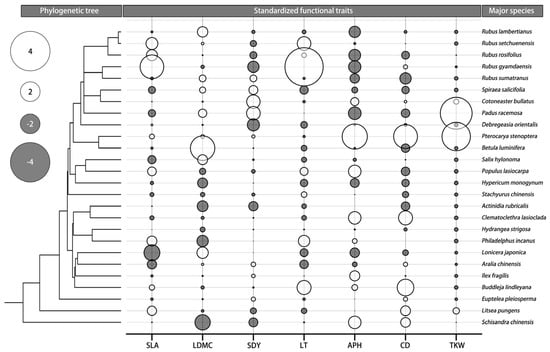
Figure 2.
Functional traits at the species scale, linked with phylogenetic relationships, after an earthquake. Phylogenetic trees are shown on the left, species names of major woody plants are shown on the right, and standardized trait values are shown in the middle. These three parts correspond to one another by row.
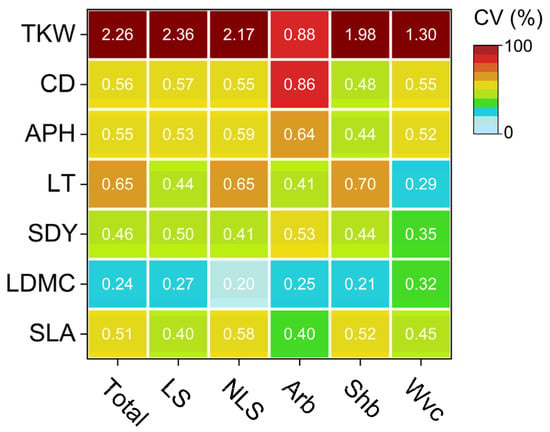
Figure 3.
Coefficient of variation of woody plant functional traits in different classes. Abbreviations are as follows: TKW, thousand kernel weight; CD, crown diameter; APH, average plant height; LT, leaf thickness; SDY, stem density; LDMC, leaf dry matter content; SLA, specific leaf area; LS: landslide; NLS: not landslide; Arb: arbor; Shb: shrubs and small size arbor; Wvc: Woody vines and climbing shrubs.
Leaf traits (SLA, LDMC and LT) were significantly different according to whether there was a landslide, suggesting that leaves were the main functional unit to adapt to the new environment at landslide sites (Figure 3). One of the main reasons for the difference in traits was that the species composition at the landslide sites changed compared with that at the nonlandslide sites (Table 1). According to the WFT classification, the differences in trait variation were mainly manifested in Arb and Wvc compared with all woody species (Figure 3), e.g., the average APH and TKW of Arb were higher than those of Shb and Wvc; the average LT of Wvc was lower than those of Arb and Shb (Figure S2 in the Supplementary material).

Table 1.
Differences of woody plant species between landslide and sympatric sites unaffected by the earthquake. Only data greater than 0.05 are listed here.
3.2. Functional Traits in Different WFTs
PCA was used to assess the relationship of traits between WFTs based on the mean value of each species. As shown in Figure 4a, for all woody plants, the first two principal components of the PCA explained 30.7% and 25.4% of the variance in all the studied functional traits, respectively. Three leaf traits were integrated along Dim1, and TKW fit Dim2. SLA and LT were negatively correlated with LDMC, and CD was positively correlated with APH. For Arb, the first two components of trait PCA explained 42.5% and 28.7% of the variance in functional traits, respectively, which were higher than those when all species were considered, indicating that tree traits were more integrated and consistent. LDMC, SLA and SDY were integrated along Dim1, and CD fitted Dim2. The SLA of trees was negatively correlated with LDMC and SDY. LT was negatively correlated with TKW. For Shb, the first two components of the PCA explained 30.9% and 25.0% of the variance in functional traits, respectively. The relations between the three leaf traits were consistent with those considering all woody plants. For Wvc, the first two components of the PCA explained 46.5% and 27.5% of the variance in functional traits, respectively, which were the highest among WFTs, where LT, TKW and SLA were integrated along Dim 1 and were negatively correlated with LDMC.
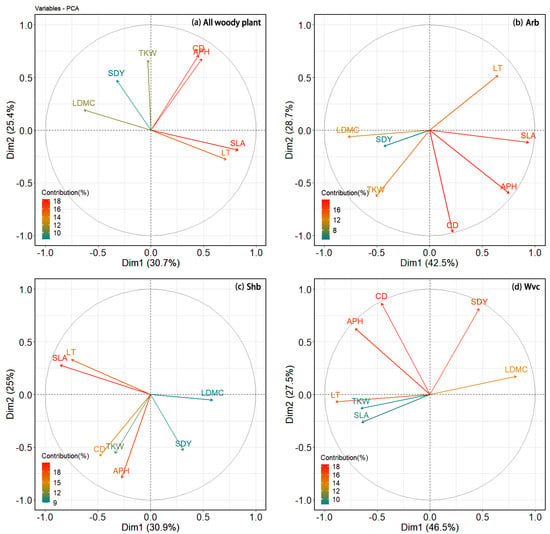
Figure 4.
Principal component analyses of woody plant functional traits across WFTs. Abbreviations are as follows: Arb, arbors; Shb: shrubs and small arbors; Wvc, woody vines and climbing shrubs; SLA, specific leaf area; LDMC, leaf dry matter content; SDY, stem density; LT, leaf thickness; APH, average plant height; CD, crown diameter; TKW, thousand kernel weight.
3.3. Functional Traits in Landslides and Nonlandslides Linked with WFTs
To fully reflect the intraspecific variation in plant traits after earthquakes, it is necessary to focus on the individual traits of each plant rather than the average trait values of each species. Since there are many factors to consider (whether the plants are on landslides or not and WFTs), the LDA method was used to cluster different WFTs based on individual traits to obtain more credible results (Figure 5). In the nonlandslide community, TKW, APH and CD were integrated along LD1, and LD1 could explain 91.52% of the variance. In the landslide community, TKW and APH were consistent, while CD and LDMC were integrated along LD1 (91.52% variance explanation) and showed a negative correlation. According to the results from sample clustering (Figure 5), the 95% confidence interval of Arb aggregation at the nonlandslide sites was completely separated from the other two WFTs. However, at the landslide sites, a completely different situation was shown; that is, Arb highly overlapped Shb and slightly overlapped Wvc. The confidence interval overlap between Shb and Wvc functional aggregation also significantly increased from nonlandslide to landslide sites. These results indicated that the functional differentiation of different WFTs was significantly reduced in the recovering communities after the earthquake.
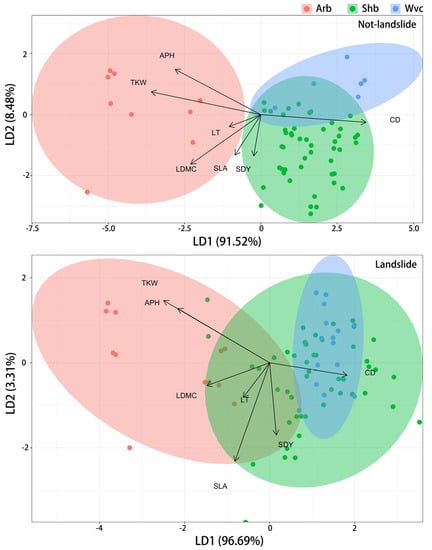
Figure 5.
Linear discriminant analysis of different WFTs in landslides and nonlandslides. Abbreviations are as follows: SLA, specific leaf area; LDMC, leaf dry matter content; SDY, stem density; LT, leaf thickness; APH, average plant height; CD, crown diameter; TKW, thousand kernel weight. The ellipse represents the 95% confidence interval.
3.4. Differences in Bivariate Functional Trait Correlations
In this study, two different scales, WFT and landslide or not, were considered. However, functional traits had a dual relationship within and between groups, no matter which grouping method was used. Differences both within and between groups were considered by using the SMA method to clarify bivariate relations of functional traits. First, this work studied differences in bivariate functional trait correlations among WFTs (Figure 6). The findings showed that four pairs of functional traits differed significantly between WFTs (Figure 6). Positive correlations were found in SDY–LDMC, LDMC–LT and SDY–LT pairs in all WFTs, although with different slopes. However, correlations of SDY and APH showed sign differences between different WFTs, which were positive in Arb and Wvc and negative in Shb.
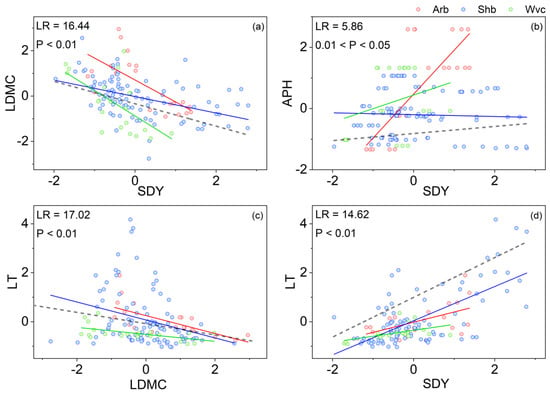
Figure 6.
SMA of correlation among woody plant functional traits across WFTs. Subfigures (a–d) show the binary relationships between different functional traits. Colors indicate individual WFTs; dashed black lines indicate significant relationships in the full dataset; the LR tests indicate significant differences between the slope of the WFT-specific SMA lines; only significantly different combinations in SMA analysis are listed here. Abbreviations are as follows: LDMC, leaf dry matter content; SDY, stem density; LT, leaf thickness; APH, average plant height.
Second, this work studied differences in trait correlation based on whether the communities were grouped on the landslide (Figure 7). Under this consideration, only two pairs of traits showed significant differences in slope, but their trends were generally the same. That is, LDMC was negatively correlated with SDY and LT in both landslides and nonlandslides. The slope of the negative correlation between LDMC and SDY was steeper on landslides, while the slope of the negative correlation with LT was more moderate in nonlandslides. To further study whether the earthquake caused the variation in traits in key woody plant species, species with a large variation in single traits after the earthquake were shown on a volcano map (Figure S3 in the Supplementary material). The results showed that the SLA of Buddleja lindleyana, LT of Stachyurus chinensis, APH of Spiraea salicifolia and CD of Cotoneaster bullatus had greater differences. The importance values of the above four plants were 0.107, 0.023, 0.034 and 0.052, ranking 4th, 15th, 18th and 27th, respectively, among all 37 woody plant species in order of importance value from high to low. In conclusion, the earthquake did not change the sign of the correlation between woody plant traits at the community scale, but the slope of the correlation between some traits related to vegetative growth (matter accumulation) changed significantly, and the functional traits of some important species were changed.
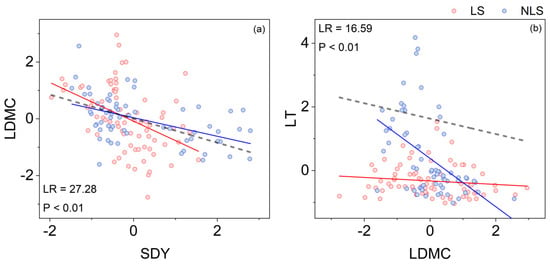
Figure 7.
SMA of correlation among woody plant functional traits between landslides and nonlandslides. Subfigures (a,b) show the binary relationships between different functional traits. Colors indicate individual WFTs; broken black lines indicate significant relationships in the full dataset; the LR tests indicate significant differences between the slope of the WFT-specific SMA lines; only significantly different combinations in SMA analysis are listed here. Abbreviations are as follows: LDMC, leaf dry matter content; SDY, stem density; LT, leaf thickness.
3.5. Response of Functional Traits to Factors
The GLM was used to study the two main factors (WFTs and whether landslides occurred or not) considered in this study, as well as the impact of sample site selection and species differences on trait changes (Figure 8). The results showed that WFT significantly affected SLA, LDMC and SDY. Whether landslides had a significant influence on LT, SLA, SDY and CD was significantly affected by plot selection. The species type had significant effects on SDY and LT. These results confirmed that WFT had a great influence on traits and confirmed the necessity of classification based on WFT in this study. Landslides affected the ability of plant leaves to retain water and resist drought.
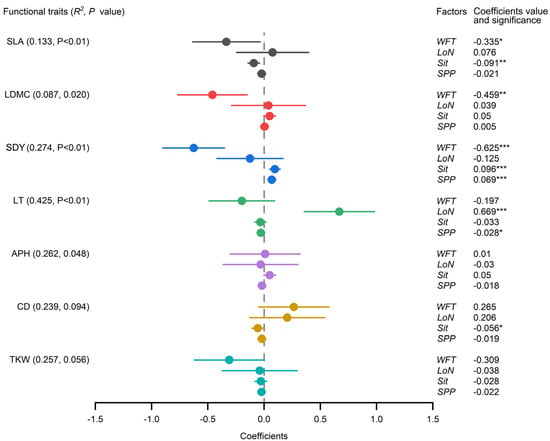
Figure 8.
Response of functional traits to WFTs, landslides, sample sites and species. Abbreviations are as follows: WFT, woody plant functional types; LoN, landslide or not; Sit, sample sites; SPP, species; SLA, specific leaf area; LDMC, leaf dry matter content; SDY, stem density; LT, leaf thickness; APH, average plant height; CD, crown diameter; TKW, thousand kernel weight; *, p < 0.05; **, p < 0.01; ***, p < 0.001.
RDA was used to study the effect of environmental factors on functional traits (Figure 9). RDA1 accounted for 62.54% of the total variance, and RDA2 accounted for 19.60% of the total variance, with both components totaling 82.14%. The results indicated that leaf traits exhibited an obvious synergy in their environmental response. Specifically, CD and APH, two characteristics describing size, also showed a synergistic environmental response. SLA, LDMC and LT were positively correlated with SLO and LIT. SDY was positively correlated with S-w and negatively correlated with Co-H and SP-Q. CD and APH were positively correlated with ATT and SOC. TKW was negatively correlated with SLO and LIT.
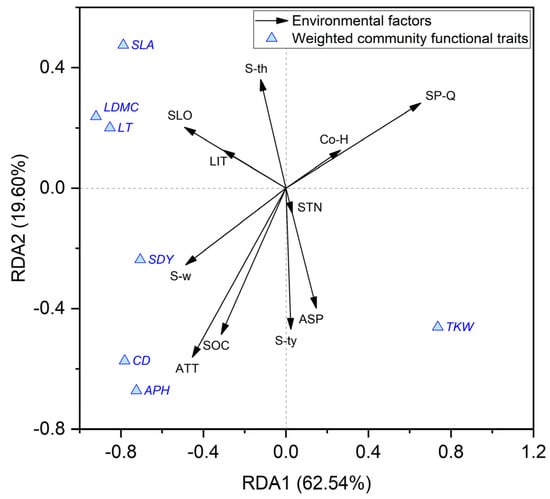
Figure 9.
Response of functional traits to compartmental factors. Abbreviations are as follows: ATT: altitude; SLO: slope degree; ASP: slope aspect; S-ty: soil types; S-th: soil thickness; S-w: soil water; SOC: soil organic carbon; STN: soil total nitrogen; SLA, specific leaf area; LDMC, leaf dry matter content; SDY, stem density; LT, leaf thickness; APH, average plant height; CD, crown diameter; TKW, thousand kernel weight.
4. Discussion
4.1. Basic Characteristics of Woody Plants
The functional traits of woody plants are important indicators in the study of forest regeneration after disturbance and are of great significance for evaluating ecological strategies and evolutionary trade-offs for forest recovery [24,25]. The results of this study showed that the total variation in traits was the highest in TKW, and the variations in leaf thickness, CD, APH and SLA were also higher than 50%. LDMC was the most stable among all traits. This is consistent with previous research results in which LDMC was not affected by leaf shape; therefore, variation is mainly from interspecific sources, and the species pool similarity makes LDMC more stable when considering community-scale traits in the same area [26]. Among the different WFTs, the morphological traits of arbors, vines and climbers varied greatly, while the leaf thickness and SLA of shrubs and small arbors leaves varied greatly. This phenomenon suggests that arbors and interlayer plants acquire resources by regulating individual size and differentiation of their spatial niche, while shrubs and small arbors regulate their survival strategies by regulating leaf storage and light availability [27,28]. The variation index of leaf traits (SLA, LDMC and leaf thickness) on landslide communities was significantly different from that on nonlandslides, suggesting that at the community scale, woody plant leaves were the main functional organs that adapted to the new environment after the earthquake, adapting to the postlandslide environment by regulating light availability and leaf matter storage [29].
In the early stage of landslide succession, ecological strategies of woody plants often adopted a mode of quick investment and quick return, which they manifested by adjusting their leaf traits to obtain a high photosynapse rate and high respiration rate, but they were gradually replaced by slow-investment species in the late stage of succession [10,30]. Trait regulation at the community scale is usually due to changes in species composition (Table 1). It should be noted that no synergistic relationship between traits and phylogenetic distance was found in this study, which was different from the findings of some previous studies that reported the existence of evolutionary constraints on plant functioning and distribution [31]. This was because the traits were environment-dependent, and the relationship between functional traits and phylogeny may vary or even change direction due to environmental conditions [23,32]. Meanwhile, the responses of different traits to phylogeny were also different [30]. Similarly, a previous study in this region calculated Blomberg’s K-value for woody plant functional traits after the earthquake and showed that there were no significant phylogenetic signals for most of the functional traits of the woody plants on landslides [8]. Therefore, no significant consistency between traits and phylogeny was found in this region after the earthquake, which may be due to the local environmental characteristics and limited selection of traits. This speculation needs to be confirmed by more targeted experiments.
4.2. Differences in Functional Traits between Landslides and WFTs
Functional traits not only reflect the functions of individual plants to meet their physiological needs, but also reflect the functions and roles of the plants in the ecosystem [24]. Therefore, the study of plant functional traits should not treat all species as equivalent, but should make multiple comparisons based on different ecological functional types [6,33]. The findings suggested evidence for differences and similarities in multitrait coordination when the three WFTs were considered separately (Figure 4). For example, leaf traits were integrated along the first functional dimension when all species were considered, as were shrubs, small arbors and interlayer plants when they were considered separately. This represents the synergistic effect of various functional traits in leaves, especially in SLA and leaf thickness (Figure 4a–d). Similarly to this study, Akram et al. [12] and Wang et al. [34] reported that SLA was greatly influenced by leaf thickness. However, LDMC showed a negative relationship with SLA and leaf thickness. In general, this pattern is related to the drought resistance of plants, e.g., a higher LDMC linked with a lower SLA could hinder water spread from inside the leaves to their surface to prevent excessive loss of water [34]. However, this relationship becomes difficult to maintain when arbors are considered separately. The most obvious change was that the relationship between leaf thickness and the first axis weakened, while the stem density was highly correlated with LDMC. This is usually because trees need to invest more resources in supporting structures to support their leaves to occupy higher positions in the forest [9,35]. The LDMC showed the least significant change between all plants and WFTs, which once again suggested its stability. In conclusion, the stability of different traits among WFTs was different, and the overall stability of stem and leaf organ traits was higher than that of reproductive and size-related traits.
Intercorrelations of functional traits are helpful to better understand the ecological strategies and evolutionary trade-offs of plants [8,24]. The differences in ecological functional strategies among different types of plants also leads to changes in the relationship between traits. Therefore, it is worth considering the binary relationships between traits among different functional types of plants [6]. In this study, the relationship between stem density and several functional traits changed significantly in WFTs. There is evidence that both leaf and stem traits change from “rapid growth” to “slow accumulation” modes with increasing plant age, which may be triggered by plant growth and development at the individual scale or by changes in species composition at the community scale [10,36]. In summary, the matter accumulation of stems and leaves has similar ecological rules over time. However, in this study, stem density was negatively correlated with LDMC, which may be because the time series (succession stage or individual size) was not used as a covariate in this study.
The results of this study also showed that the relationship between stem density and plant height changed greatly among WFTs, and the stem density of arbors and interlayer plants showed a significant positive correlation with height, while shrubs and small arbors were different. This is because height is related to the ecological strategy of increasing the light availability of trees, which requires stem support [6,37]. There was a positive correlation between stem density and leaf thickness, which showed little change between WFTs. Notably, there was a negative correlation between leaf thickness and LDMC. Similarly to this study, Tang et al. [38] reported that the growth rates in leaf dry weight and leaf thickness of Hippophae rhamnoides were significantly different. This indicated that the increase in leaf thickness in the study area may have been more related to water storage and aeration than to dry matter accumulation [39], and this trend was more obvious in trees and mesenchymal plants. In summary, changes in intercorrelations of functional traits between WFTs were mostly reflected by leaves and stems.
To further study the effect of the earthquake on functional traits, the relationships among traits between WFTs on landslides and nonlandslides was analyzed based on LDA at the individual scale (Figure 5). The results showed that there was still a high consistency of leaf traits (smaller vector angle), and this consistency was more prominent in nonlandslide communities. Interestingly, the differentiation of functional traits of recovered communities decreased significantly along WFTs (more overlaps in confidence intervals). The decrease in ecological functional differentiation is a manifestation of reverse succession, which may result from changes in species after major disturbance, i.e., changes in the composition and number of plants of various functional types to adapt to changes in the environment and resource availability [31,40]. This indicated that the historical pattern of resource allocation was disrupted, resulting in a redistribution of resources. At the same time, it was also confirmed that the primary community adjacent to the landslide could not quickly spread to the landslide and assimilate the landslide’s community into a similar composition. That is, gaps caused by landslides had different regeneration and succession processes to those caused by other types of tree death.
This study also found that there were significant differences in plant reproductive and size traits between WFTs, regardless of whether they were on the landslides (Table S4). On slopes, the SLA was significantly different among WFTs on the landslides. However, the SDY was significantly different from that of WFTs in nonlandslide samples (Table S3). This indicated that in the early stage of postsuccession after large-scale natural disturbance, plants mostly adopt an ecological strategy of rapid growth and improve light use efficiency through the differentiation of their leaf function with a shorter growth cycle [41]. Nonlandslide communities are more mature, and woody plants tend to construct multistory community structures based on differences in their support structures (slow investment) to improve light efficiency [42,43].
In addition to differences in functional differentiation, the slope of the linear relationship between the LDMC and stem density and leaf thickness changed significantly, although they were both negatively correlated. The negative correlation between the stem density and LDMC of slope woody plants increased, which may be caused by the loss of trees, which is consistent with the discussion above. A very significant negative correlation was also found between LDMC and leaf thickness in nonlandslide woody plants (Figure 7b). These results suggested that the ecological strategies of broadleaved woody plants in this region were more likely to enhance their competitive ability by increasing light utilization efficiency rather than by increasing leaf storage. In general, increases in leaf thickness are often associated with water and material storage, which is often a survival strategy for plants in arid and poor environments [44,45]. The findings of this study support this hypothesis in the case of geological disturbance; that is, the slope of the negative correlation between LDMC and leaf thickness became very gentle on the landslides (Figure 7b and Figure S2), indicating that the ecological strategy of leaf storage was more suitable on landslides than on nonlandslides.
4.3. Factors Affecting Traits
A large number of previous studies have focused only on the effects of different classification methods, sampling methods and species on functional traits [6,15]. Not only was the GLM used to study the response of traits to different classifications (Figure 8), but RDA was also used to study the influence of specific environmental factors on each trait (Figure 9). The results showed that the response of different functional traits to various factors was different. Leaf area, dry matter content and stem density were more sensitive to WFTs, while leaf thickness was more sensitive to slope. This is highly consistent with the discussion above; therefore, it will not be discussed again here. In addition, stem density was sensitive to species and plot selection factors.
In terms of specific environmental factors, leaf traits showed a highly coordinated environmental response and were affected by slope and litter storage. This may have been related to litter decomposition; that is, higher values of the three leaf traits occurring at the same time represented the ecological strategy of high photosynthetic input, and a higher leaf biomass led to an increase in litter quantity on the surface. Similar to these conclusions, researchers have also reported that leaf traits are directly related to the litter amount, and leaf traits can also be used to predict litter decomposition rates [46,47,48]. Plant size factors (crown diameter and height) also showed similarity in environmental response, i.e., altitude and soil organic carbon were more affected. This is due to species differences due to altitude, as well as differences in ecotypes of the same species [49]. Soil organic carbon was the most representative index reflecting soil nutrients, which contributed to the growth of plant size. In conclusion, the sensitivity of woody plant functional traits to WFTs and earthquakes was different. In regard to environmental factors, woody plant traits were regulated by geographic and soil factors rather than biological factors.
5. Conclusions
The interspecific variation in woody plant functional traits was greater than intraspecific variation on the whole. The variation ratio stability showed that the stem and leaf traits were more stable than were the reproductive and morphological traits. The variation in woody plant traits on landslides was mainly in the leaves. Leaf traits were highly cooperative at both the species scale and the individual scale. The changes in the correlation between functional traits between WFTs were mainly reflected in the leaves and stems. The differentiation of the functional traits of woody plants on landslides decreased significantly along WFTs compared with that on nonlandslides. Plants on the landslides adapted to the new environment by adjusting their leaf traits and adopting an ecological strategy of rapid growth. In contrast, nonlandslide plants were more inclined to accumulate material and support structures. The sensitivity of different traits to WFTs and landslides was different. For specific environmental factors, the woody plants traits were regulated by geographic and soil factors rather than biological factors.
This study provides a typical case of and a detailed data analysis for the theoretical study of vegetation functional restoration and variation after earthquakes. However, there are still some shortcomings to be addressed in future studies: (1) The selection of functional traits was limited to morphology, weight, density, etc., and did not consider internal traits, such as the element content of plant organs. (2) Sensitive species with trait variation were preliminarily studied in this work, but the status of these species in the community remains unclear. Can they become new dominant species? How much do these species contribute to the restoration of communities after earthquakes? (3) Are there differences in adaptation mechanisms and evolutionary trade-offs for intraspecific trait variation in different sensitive species? These issues will be clarified in future studies.
Supplementary Materials
The following supporting information can be downloaded at: https://www.mdpi.com/article/10.3390/f13081323/s1, Figure S1: Schematic diagram of landslide mass structure.; Figure S2: Functional traits of share species in both landslide and not-landslide area; Figure S3: Key species of difference in functional traits between landslide and not-landslide; Table S1: Mean monthly averages of climate data for the last 50 years; Table S2: Details of sampling sites; Table S3: Abbreviations of this study; Table S4: One-way variance analysis of woody plant functional traits between WFTs on landslide and not-landslide.
Author Contributions
D.K. conceived of, wrote and organized the manuscript. C.Y., S.L., L.C., S.Z. and D.Z. participated in the trials. All authors have read and agreed to the published version of the manuscript.
Funding
This research was funded by the National Natural Science Foundation of China, grant number 31800458.
Institutional Review Board Statement
Not applicable.
Informed Consent Statement
Not applicable.
Data Availability Statement
The data presented in this study are available on request from the corresponding author.
Acknowledgments
The authors are grateful for the field support from the Longxi Hongkou National Nature Reserve.
Conflicts of Interest
The authors declare no conflict of interest.
References
- Allen, R.B.; Bellingham, P.J.; Wiser, S.K. Immediate damage by an earthquake to a temperate montane forest. Ecology 1999, 80, 708–714. [Google Scholar] [CrossRef]
- Wells, A.; Duncan, R.P.; Stewart, G.H. Forest dynamics in Westland, New Zealand: The importance of large, infrequent earthquakeinduced disturbance. J. Ecol. 2001, 89, 1006–1018. [Google Scholar] [CrossRef]
- Kang, D.; Yin, C.J.; Zhu, D.H.; Zou, S.Z. Altitude and landslide scale regulated the assembly of grassland communities on landslides during the recovery process after the magnitude 8.0 Wenchuan earthquake, China. Ecol. Eng. 2021, 172, 106413. [Google Scholar] [CrossRef]
- Bailey, W. World Earthquake Belts. Sci. Am. 1928, 4, 306–309. [Google Scholar]
- Poorter, H.; Niklas, K.J.; Reich, P.B.; Oleksyn, J.; Poot, P.; Mommer, L. Biomass allocation to leaves, stems and roots: Meta–analyses of interspecific variation and environmental control. New Phytol. 2012, 193, 30–50. [Google Scholar] [CrossRef] [PubMed]
- Fyllas, N.M.; Michelaki, C.; Galanidis, A.; Evangelou, E.; Zaragoza-Castells, J.; Dimitrakopoulos, P.G.; Tsadilas, C.; Arianoutsou, M.; Lloyd, J. Functional Trait Variation Among and Within Species and Plant Functional Types in Mountainous Mediterranean Forests. Front. Plant Sci. 2020, 11, 212. [Google Scholar] [CrossRef] [PubMed]
- Pierick, K.; Leuschner, C.; Homeier, J. Topography as a factor driving small-scale variation in tree fine root traits and root functional diversity in a species-rich tropical montane forest. New Phytol. 2021, 230, 129–138. [Google Scholar] [CrossRef] [PubMed]
- Kang, D.; Zou, S.; Ma, L.; Yin, C.; Zhu, D.H. Abiotic Regulation: Landslide Scale and Altitude Regulate Functional Traits of Regenerating Plant Communities After Earthquakes. Front. Ecol. Evol. 2022, 10, 846642. [Google Scholar] [CrossRef]
- Poorter, H.; Evans, J.R. Photosynthetic nitrogen-use efficiency of species that differ inherently in specific leaf area. Oecologia 1998, 116, 26–37. [Google Scholar] [CrossRef] [PubMed]
- Wright, I.J.; Reich, P.B.; Westoby, M.; Ackerly, D.D.; Baruch, Z.; Bongers, F.; Cavender–Bares, J.; Chapin, T.; Cornelissen, J.H.C.; Diemer, M.; et al. The worldwide leaf economicsspectrum. Nature 2004, 428, 821–827. [Google Scholar] [CrossRef]
- Kong, D.; Ma, C.; Zhang, Q.; Li, L.; Chen, X.; Zeng, H.; Guo, D. Leading dimensions in absorptive root trait variation across 96 subtropical forest species. New Phytol. 2014, 203, 863–872. [Google Scholar] [CrossRef]
- Akram, M.A.; Zhang, Y.H.; Wang, X.T.; Shrestha, N.; Malik, K.; Khan, I.; Ma, W.J.; Sun, Y.; Li, F.; Ran, J.Z.; et al. Phylogenetic independence in the variations in leaf functional traits among different plant life forms in an arid environment. J. Plant Physiol. 2022, 272, 153671. [Google Scholar] [CrossRef]
- Akram, M.A.; Wang, X.; Hu, W.; Xiong, J.; Zhang, Y.; Deng, Y.; Ran, J.; Deng, J.M. Convergent Variations in the Leaf Traits of Desert Plants. Plants 2020, 9, 990. [Google Scholar] [CrossRef] [PubMed]
- Dwyer, J.M.; Hobbs, R.J.; Mayfield, M.M. Specific leaf area responses to environmental gradients through space and time. Ecology 2014, 95, 399–410. [Google Scholar] [CrossRef] [PubMed]
- Henn, J.J.; Damschen, E.I. Plant age affects intraspecific variation in functional traits. Plant Ecol. 2021, 222, 669–680. [Google Scholar] [CrossRef]
- Westoby, W.M. Leaves at Low versus High Rainfall: Coordination of Structure, Lifespan and Physiology. New Phytol. 2002, 155, 403–416. [Google Scholar]
- Bellingham, P.J.; Sparrow, A.D. Resprouting as a Life History Strategy in Woody Plant Communities. Oikos 2000, 89, 409–416. [Google Scholar] [CrossRef]
- Box, E.O.; Fujiwara, K. Warm–Temperate Deciduous Forests around the Northern Hemisphere; Springer: Berlin, Germany, 2015. [Google Scholar]
- Yao, S.; Akram, M.A.; Hu, W.; Sun, Y.; Sun, Y.; Deng, Y.; Ran, J.; Deng, J. Effects of Water and Energy on Plant Diversity along the Aridity Gradient across Dryland in China. Plants 2021, 10, 636. [Google Scholar] [CrossRef]
- Hu, W.; Ran, J.; Dong, L.; Du, Q.; Ji, M.; Yao, S.; Sun, Y.; Gong, C.; Hou, Q.; Gong, H.; et al. Aridity-driven shift in biodiversity–soil multifunctionality relationships. Nat. Commun. 2021, 12, 5350. [Google Scholar] [CrossRef]
- Perez-Harguindeguy, N.; Diaz, S.; Garnier, E.; Lavorel, S.; Poorter, H.; Jaureguiberry, P.; Bret-Harte, M.S.; Cornwell, W.K.; Craine, J.M.; Gurvich, D.E.; et al. New handbook for standardised measurementof plant functional traits worldwide. Aust. J. Bot. 2013, 61, 167–234. [Google Scholar] [CrossRef]
- Kjeldahl, J.Z. New method for the determination of nitrogen in organic substances. Z. Anal. Chem. 1883, 22, 366. [Google Scholar] [CrossRef]
- Zanne, A.E.; Tank, D.C.; Cornwell, W.K.; Eastman, J.M.; Smith, S.A.; FitzJohn, R.G.; McGlinn, D.J.; O’Meara, B.C.; Moles, A.T.; Reich, P.B.; et al. Three keys to the radiation of angiosperms into freezing environments. Nature 2014, 506, 89–92. [Google Scholar] [CrossRef] [PubMed]
- Bruelheide, H.; Dengler, J.; Purschke, O.; Lenoir, J.; Jiménez-Alfaro, B.; Hennekens, S.M.; Botta-Dukát, Z.; Chytrý, M.; Field, R.; Jansen, F.; et al. Global trait–environment relationships of plant communities. Nat. Ecol. Evol. 2018, 2, 1906–1917. [Google Scholar] [CrossRef] [PubMed]
- Ma, Z.; Guo, D.; Xu, X.; Lu, M.; Bardgett, R.D.; Eissenstat, D.M.; McCormack, M.L.; Hedin, L.O. Evolutionary history resolves global organization of root functional traits. Nature 2018, 555, 94–97. [Google Scholar] [CrossRef] [PubMed]
- Huang, W.J.; Li, Z.J.; Yang, Z.P.; Bai, G. The structural traits of Populus euphratica heteromorphic leaves and their correlations. Acta Ecol. Sin. 2010, 30, 4636–4642. [Google Scholar]
- Reich, P.B.; Walters, M.B.; Ellsworth, D.S. Leaf life–span in relation to leaf, plant, and stand characteristics among diverse ecosystems. Ecol. Monogr. 1992, 62, 365–392. [Google Scholar] [CrossRef]
- Su, P.X.; Zhang, L.X.; Du, M.W.; Bi, Y.R.; Zhao, A.F.; Liu, X.M. Photosynthetic character and water use efficiency of different leaf shapes of populus euphratica and their response to co2 enrichment. Acta Phytoecol. Sin. 2003, 27, 34–40. [Google Scholar]
- Qi, L.Y.; Chen, H.N.; Kulihong, S.; Ji, T.-Y.; Meng, G.-D.; Qin, H.-Y.; Wang, N.; Song, Y.-X.; Liu, C.-Y.; Du, N.; et al. Growth strategies of five shrub seedlings in warm temperate zone based on plant functional traits. Acta Phytoecol. Sin. 2022, 46, 1–12. [Google Scholar]
- Kelly, R.; Healy, K.; Anand, M.; Baudraz, M.E.A.; Bahn, M.; Cerabolini, B.E.L.; Cornelissen, J.H.C.; Dwyer, J.M.; Jackson, A.L.; Kattge, J.; et al. Climatic and evolutionary contexts are required to infer plant life history strategies from functional traits at a global scale. Ecol. Lett. 2021, 24, 970–983. [Google Scholar] [CrossRef]
- Griffith, D.M.; Osborne, C.P.; Edwards, E.J.; Bachle, S.; Beerling, D.J.; Bond, W.J.; Gallaher, T.J.; Helliker, B.R.; Lehmann, C.E.; Leatherman, L.; et al. Lineage-based functional types: Characterising functional diversity to enhance the representation of ecological behaviour in Land Surface Models. New Phytol. 2020, 228, 15–23. [Google Scholar] [CrossRef] [PubMed]
- Reich, P.B.; Wright, I.J.; Cavender-Bares, J.; Craine, J.M.; Oleksyn, J.; Westoby, M.; Walters, M.B. The evolution of plant functional variation: Traits, spectra, and strategies. Int. J. Plant Sci. 2003, 164, 143–164. [Google Scholar] [CrossRef]
- Niu, K.; Zhang, S.; Lechowicz, M.J. Harsh environmental regimes increase the functional significance of intraspecific variation in plant communities. Funct. Ecol. 2020, 34, 1666–1677. [Google Scholar] [CrossRef]
- Wang, F.; Guo, S.J.; Fan, B.L.; Han, F.G.; Wang, F.L.; Zhang, W.X.; Zhang, Y.N. Plant Leaf Traits in Minqin Oasis–desert Transition Zone. Bull. Bot. Res. 2022, 42, 71–80. [Google Scholar]
- Peter, A.W. Functional trait shifts after disturbance reveal broad-scale variability in temperate forest regional recruitment processes. J. Veg. Sci. 2018, 29, 491–500. [Google Scholar]
- Mason, C.M.; McGaughey, S.E.; Donovan, L.A. Ontogeny strongly and differentially alters leaf economic and other key traits in three diverse Helianthus species. J. Exp. Bot. 2013, 64, 4089–4099. [Google Scholar] [CrossRef]
- Fort, F.; Freschet, G.T. Plant ecological indicator values as predictors of fine–root trait variations. J. Ecol. 2020, 108, 1565–1577. [Google Scholar] [CrossRef]
- Tang, Y.R.; Zhao, C.Z.; Zhao, H.; Hou, G.; Ma, M.; Zhao, T.T.; Wang, Y.F.; Zeng, H.X. The relationship between leaf dry mass and leaf area, leaf thickness of Hippophae rhamnoides under different light conditions in Taohe River riparian forest. Chin. J. Ecol. 2021, 40, 2745–2753. [Google Scholar]
- Terashima, I.; Hanba, Y.T.; Tazoe, Y.; Vyas, P.; Yano, S. Irradiance and phenotype: Comparative eco–development of sun and shade leaves in relation to photosynthetic CO2 diffusion. J. Exp. Bot. 2006, 57, 343–354. [Google Scholar] [CrossRef]
- Botha, M.; Siebert, S.J.; Van den Berg, J.; Ellis, S.M.; Dreber, N. Plant functional types differ between the grassland and savanna biomes along an agro–ecosystem disturbance gradient in South Africa. S. Afr. J. Bot. 2017, 113, 308–317. [Google Scholar] [CrossRef]
- Garnier, E.; Cortez, J.; Billès, G.; Navas, M.-L.; Roumet, C.; Debussche, M.; Laurent, G.; Blanchard, A.; Aubry, D.; Bellmann, A.; et al. Plant functional markers capture ecosystem properties during secondary succession. Ecology 2004, 85, 2630–2637. [Google Scholar] [CrossRef]
- Huston, M.A.; Smith, T. Plant succession: Life history and competition. Am. Nat. 1987, 130, 168–198. [Google Scholar] [CrossRef]
- Bazzaz, F.A. Plants in Changing Environments: Linking Physiological, Population, and Community Ecology; Cambridge University Press: Cambridge, UK, 1996. [Google Scholar]
- Westoby, M.; Falster, D.S.; Moles, A.T.; Vesk, P.A.; Wright, I.J. Plant ecological strategies: Some leading dimensions of variation between species. Annu. Rev. Ecol. Syst. 2002, 33, 125–159. [Google Scholar] [CrossRef]
- Velikova, V.; Arena, C.; Izzo, L.G.; Tsonev, T.; Koleva, D.; Tattini, M.; Roeva, O.; De Maio, A.; Loreto, F. Functional and Structural Leaf Plasticity Determine Photosynthetic Performances during Drought Stress and Recovery in Two Platanus orientalis Populations from Contrasting Habitats. Int. J. Mol. Sci. 2020, 21, 3912. [Google Scholar] [CrossRef] [PubMed]
- Rawat, J.E.; Cawson, J.G.; Filkov, A.I.; Penman, T.D. Leaf traits predict global patterns in the structure and flammability of forest litter beds. J. Ecol. 2021, 109, 1344–1355. [Google Scholar]
- Rawat, M.; Arunachalam, K.; Arunachalam, A.; Alatalo, J.M.; Pandey, R. Predicting litter decomposition rate for temperate forest tree species by the relative contribution of green leaf and litter traits in the Indian Himalayas region. Ecol. Indic. 2020, 119, 106827. [Google Scholar] [CrossRef]
- Rosenfield, M.V.; Keller, J.K.; Clausen, C.; Cyphers, K.; Funk, J.L. Leaf traits can be used to predict rates of litter decomposition. Oikos 2020, 129, 1589–1596. [Google Scholar] [CrossRef]
- Beall, C.M. Two routes to functional adaptation: Tibetan and Andean high–altitude natives. Proc. Natl. Acad. Sci. USA 2007, 104, 8655–8660. [Google Scholar] [CrossRef] [PubMed]
Publisher’s Note: MDPI stays neutral with regard to jurisdictional claims in published maps and institutional affiliations. |
© 2022 by the authors. Licensee MDPI, Basel, Switzerland. This article is an open access article distributed under the terms and conditions of the Creative Commons Attribution (CC BY) license (https://creativecommons.org/licenses/by/4.0/).